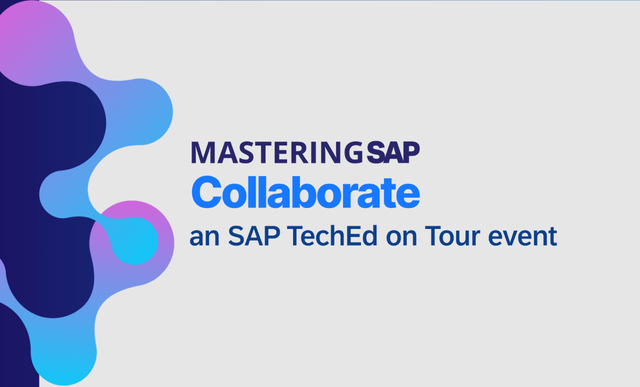SAP Process Control
Filter By
Browse By
- SAP Analytics and AI
- SAP Application Development and Integration
- All SAP Application Development and Integration
- SAP ABAP
- SAP ABAP Development Tools
- SAP ABAP Test Cockpit
- SAP API Management
- SAP BAPI
- SAP Basis
- SAP BRF
- SAP Business Application Studio
- SAP CMS
- SAP Design Studio
- SAP Development Tools
- SAP DevOps
- SAP EAI
- SAP EDI
- SAP Extension Suite
- SAP Fiori
- SAP Fiori Elements
- SAP Integration Suite
- SAP Low Code Application Development
- SAP Low Code Automation
- SAP Netweaver
- SAP Release Management
- SAP UI5
- SAP Web Application Server
- SAP Web IDE
- SAP Business Process Management
- SAP Center of Excellence
- SAP CIO
- SAP Customer Experience
- SAP Data and Data Management
- All SAP Data and Data Management
- SAP BW
- SAP BW/4HANA
- SAP Crystal Reports
- SAP Data Archiving
- SAP Data Center
- SAP Data Governance
- SAP Data Integration
- SAP Data Migration
- SAP Data Quality
- SAP Data Services
- SAP Data Strategy
- SAP Data Visualization
- SAP Data Warehouse Cloud
- SAP DMS
- SAP Document Control
- SAP EIM
- SAP ETL
- SAP ETL Tools
- SAP HANA
- SAP HANA Administration
- SAP HANA Deployment Infrastructure
- SAP HANA Studio
- SAP Master Data
- SAP Master Data Governance
- SAP MDM
- SAP Enterprise Architect
- SAP Enterprise Asset Management
- SAP ERP
- SAP Finance
- All SAP Finance
- SAP Accounting
- SAP AR AP
- SAP Asset Accounting
- SAP Billing Systems
- SAP BPC
- SAP BRIM
- SAP Cash Management
- SAP Central Finance
- SAP Controlling
- SAP COPA
- SAP Cost Center Accounting
- SAP Currency Risk
- SAP e-invoicing
- SAP FICO
- SAP Finance Automation
- SAP Advanced Financial Closing
- SAP Financial Consolidation
- SAP Financial Planning
- SAP FX Risk
- SAP General Ledger
- SAP Global Tax Management
- SAP Hyperion
- SAP Order to Cash
- SAP Payment Processing
- SAP Profitability Analysis
- SAP Rebate Management
- SAP S/4HANA Finance
- SAP SWIFT Compliance
- SAP Treasury Management
- SAP Universal Journal
- SAP Governance Risk and Compliance
- SAP Human Capital Management
- SAP Intelligent Technologies
- SAP Platform and Technology
- All SAP Platform and Technology
- SAP Business Technology Platform
- SAP Cloud
- SAP Cloud Connector
- SAP Cloud Integration Platform
- SAP Cloud Migration
- SAP Cloud Platform
- SAP Cloud Providers
- SAP Cloud Strategy
- SAP Digital Signature
- SAP Container Platform
- SAP HANA Enterprise Cloud
- SAP Digital Asset Management
- SAP Smart Forms
- SAP HEC
- SAP Digital Integration Hub
- SAP Hyperscalers
- SAP Infrastructure
- SAP Messaging
- SAP Quality and Testing
- SAP Security
- SAP Spend Management
- SAP Supply Chain Management
- All SAP Supply Chain Management
- SAP APO
- SAP Asset Management
- SAP Business Network
- SAP Digital Manufacturing Cloud
- SAP Digital Twin
- SAP EWM
- SAP IBP
- SAP Inventory Management
- SAP Label Printing
- SAP Logistics
- SAP Manufacturing
- SAP Manufacturing Automation
- SAP MES
- SAP MII
- SAP MM
- SAP MRO
- SAP MRP
- SAP Order Management
- SAP Plant Maintenance
- SAP PLM
- SAP Production Planning
- SAP S&OP
- SAP SD
- SAP SPM
- SAP Supply Chain Planning
- SAP Track and Trace
- SAP Transportation Management
- SAP System Administration
What is SAP Process Control?
Companies need to ensure their activities are carried out following board-level directives and internal policies while complying with applicable regulations. That’s where internal controls come into play, and process control is a method that companies use to streamline and automate the monitoring of business processes. SAP Process Control, part of the SAP GRC suite, is one tool that many SAP customers use to ensure their business is operating in an efficient and compliant manner.
What is SAP Process Control?
Companies need to ensure their activities are carried out following board-level directives and internal policies while complying with applicable regulations. That’s where internal controls come into play, and process control is a method that companies use to streamline and automate the monitoring of business processes. SAP Process Control, part of the SAP GRC suite, is one tool that many SAP customers use to ensure their business is operating in an efficient and compliant manner.
SAP Process Control and similar tools offer the following capabilities, among others:
- Continuous controls monitoring (CCM), which automates the monitoring of process data.
- Single source of process control data, including internal procedures and compliance policies
- Business objective and risk alignment with controls
- Automated workflows and notifications for issue response
- Internal controls evaluation
Process Control is largely manual without a targeted solution. Automation with the help of technology enables faster response to efficiency and compliance issues, while reducing workload for GRC teams.
There are many vendors that provide services and products around process control. For example, Appsian Security’ssolutions offer attribute-based controls monitoring, continuous monitoring, and real-time process analytics. System integrators such as Capgemini, Deloitte, and Accenture assist customers with establishing process controls policies and implementing SAP Process Control and other software.
Key Considerations for SAPinsiders:
- CCM automation is an appealing piece of SAP Process Control for many SAP customers. For example, as part of an SAP Process Control implementation, Eli Lilly utilized CCM to help track the company’s controlled activities. This has helped increase transparency and efficiency in the controls process.
- Business partners need to be involved in SAP Process Control. Get out in front of the process with your business partners so you can inform and co-create, making them aware of control considerations that will impact their decisions. Challenge your current processes and leverage technology and external expertise to support adoption and behavior change. Asking questions like “what is your biggest pain point” and “how do we benchmark against our peers” is important.
- Hershey is using process control to measure process and adoption rates during its phased SAP S/4HANA implementation. This phased approach allows the company to understand what extent GRC is being leveraged. Using SAP Process Control, rationalization of manual controls is targeted at 35% and control automation is expected to increase from 20% to over 50%.
431 results
-

- SAP ABAP
 Premium
Premium
How to Implement Execution Steps Using the Standard XSteps Library
Reading time: 11 mins
Learn how to download, install, and use the standard Execution Steps (XSteps) library to create process instruction (PI) sheets. Learn how to use the standard XSteps to create a basic example to create a PI sheet to post a confirmation for a process order. Key Concept Process instruction (PI) sheets are the default option in...…
-

 Premium
Premium
Lean Implementation of the Material Ledger with Multiple Valuations in a Production Environment
Reading time: 25 mins
Learn how to design the standard SAP system to implement the Material Ledger with multiple valuations in the production environment using the Special Purpose Ledger. The main reason to use the Special Purpose Ledger is to avoid changes required in existing currency settings and impacts on other applications that are already in use. The Special...…
-

 Premium
Premium
Implement a Compliant Identity Management Solution for Effective Provisioning, Reporting, and Role Management
Reading time: 16 mins
Learn how to achieve efficient, compliant, and secure management of user accounts and identities with SAP NetWeaver Identity Management (SAP NetWeaver IDM). Step through an overview of SAP NetWeaver IDM, including the product’s architecture and integration capabilities. Key Concept SAP NetWeaver Identity Management (SAP NetWeaver IDM) provides provisioning capabilities for SAP and third-party applications. You...…
-
-

- SAP GRC
 Premium
Premium
Unlocking the Real Power of SAP GRC Access Control Solution with VASPP Add-Ons
Reading time: 7 mins
SAP’s GRC Access Control solution is a widely recognized tool for efficiently managing user access to SAP applications. It offers a wide range of capabilities for managing user access, including automated access provisioning, access request workflows, and risk analysis along with access management automation. The solution is also capable of enforcing segregation of duties (SoD)…
-

 Premium
Premium
Hone Your Manufacturing Cost Understanding for Better Decision Making
Reading time: 16 mins
When a product is manufactured, an accounting entry is automatically made each time that a posting is made in the production process. Some of these postings take place in FI, while others are posted only in CO. Follow the flow of these accounting entries and understand the reconciliation process between FI and CO. Key Concept...…
-

 Premium
Premium
Take Remote Control of Web Intelligence Tables Using Element Links
Reading time: 10 mins
With the advent of SAP BusinessObjects BI 4.0 came the element link, a short, wizard-driven method for creating links between blocks within the same report. There is no need for a second report to refresh because the first document supplies all data. The link allows a cell in one block to act as a filter...…
-

- SAP Process Design
 Premium
Premium
Information Design Tool vs. Universe Designer: A Primer for Users
Reading time: 42 mins
Are you making the transition from Universe Designer tools to the new Information Design Tool (IDT) in SAP BusinessObjects BI 4.0? Read this report by Mike McErlain to gain an understanding of how to translate your Universe Designer skills to IDT skills. See the major differences between the two tools and get an introduction to...…
-
-

 Premium
Premium
Set Up Preference Processing to Delineate Customs Tariff Priorities and Manage Risk with Global Sourcing
Reading time: 19 mins
This walk-through of the configuration steps for Preference Processing within SAP GRC Global Trade Services Risk Management shows how to address tariff preferences in your trade application and systems. It includes setting up the communication between SAP GRC Global Trade Services and SAP ERP Central Component. Key Concept Duty and restriction applies to goods imported...…
-

 Premium
Premium
Revamp Your Exchange Process with SAP Order to Cash
Reading time: 12 mins
Learn how to exchange or replace a product and have both on the same sales order, enabling a quicker response to the customer that results in lower costs and enhanced customer satisfaction. Key Concept The consolidated exchange process is an exchange process that combines many steps of a typical SAP functionality. It consolidates these typical...…
-

- SAP AR AP
 Premium
Premium
Authorization Strategies for Credit Release Processes, Chain Sales, and Distribution
Reading time: 15 mins
Set up and configure an authorization strategy for credit representatives based on two guidelines: how much of the available credit limit a customer has used and the value of a particular sales order or delivery. Key Concept Authorization objects control release processes for credit on commercial documents in sales and distribution (SD) based on authorizations...…
Become a Member
Unlimited access to thousands of resources for SAP-specific expertise that can only be found here.
Become a Partner
Access exclusive SAP insights, expert marketing strategies, and high-value services including research reports, webinars, and buyers' guides, all designed to boost your campaign ROI by up to 50% within the SAP ecosystem.
Upcoming Events
-

Mastering SAP Collaborate, an SAP TechEd on Tour event
November 12 - 14, 2025
Sydney, New South Wales
Australia
View Event
Related Vendors
Your request has been successfully sent

